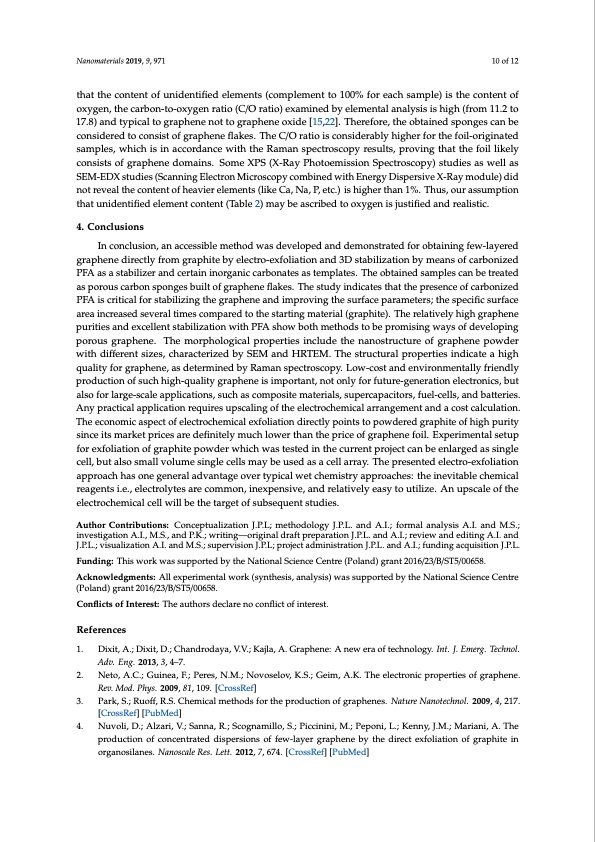PDF Publication Title:
Text from PDF Page: 010
Nanomaterials 2019, 9, 971 10 of 12 that the content of unidentified elements (complement to 100% for each sample) is the content of oxygen, the carbon-to-oxygen ratio (C/O ratio) examined by elemental analysis is high (from 11.2 to 17.8) and typical to graphene not to graphene oxide [15,22]. Therefore, the obtained sponges can be considered to consist of graphene flakes. The C/O ratio is considerably higher for the foil-originated samples, which is in accordance with the Raman spectroscopy results, proving that the foil likely consists of graphene domains. Some XPS (X-Ray Photoemission Spectroscopy) studies as well as SEM-EDX studies (Scanning Electron Microscopy combined with Energy Dispersive X-Ray module) did not reveal the content of heavier elements (like Ca, Na, P, etc.) is higher than 1%. Thus, our assumption that unidentified element content (Table 2) may be ascribed to oxygen is justified and realistic. 4. Conclusions In conclusion, an accessible method was developed and demonstrated for obtaining few-layered graphene directly from graphite by electro-exfoliation and 3D stabilization by means of carbonized PFA as a stabilizer and certain inorganic carbonates as templates. The obtained samples can be treated as porous carbon sponges built of graphene flakes. The study indicates that the presence of carbonized PFA is critical for stabilizing the graphene and improving the surface parameters; the specific surface area increased several times compared to the starting material (graphite). The relatively high graphene purities and excellent stabilization with PFA show both methods to be promising ways of developing porous graphene. The morphological properties include the nanostructure of graphene powder with different sizes, characterized by SEM and HRTEM. The structural properties indicate a high quality for graphene, as determined by Raman spectroscopy. Low-cost and environmentally friendly production of such high-quality graphene is important, not only for future-generation electronics, but also for large-scale applications, such as composite materials, supercapacitors, fuel-cells, and batteries. Any practical application requires upscaling of the electrochemical arrangement and a cost calculation. The economic aspect of electrochemical exfoliation directly points to powdered graphite of high purity since its market prices are definitely much lower than the price of graphene foil. Experimental setup for exfoliation of graphite powder which was tested in the current project can be enlarged as single cell, but also small volume single cells may be used as a cell array. The presented electro-exfoliation approach has one general advantage over typical wet chemistry approaches: the inevitable chemical reagents i.e., electrolytes are common, inexpensive, and relatively easy to utilize. An upscale of the electrochemical cell will be the target of subsequent studies. Author Contributions: Conceptualization J.P.L; methodology J.P.L. and A.I.; formal analysis A.I. and M.S.; investigation A.I., M.S., and P.K.; writing—original draft preparation J.P.L. and A.I.; review and editing A.I. and J.P.L.; visualization A.I. and M.S.; supervision J.P.L; project administration J.P.L. and A.I.; funding acquisition J.P.L. Funding: This work was supported by the National Science Centre (Poland) grant 2016/23/B/ST5/00658. Acknowledgments: All experimental work (synthesis, analysis) was supported by the National Science Centre (Poland) grant 2016/23/B/ST5/00658. Conflicts of Interest: The authors declare no conflict of interest. References 1. Dixit, A.; Dixit, D.; Chandrodaya, V.V.; Kajla, A. Graphene: A new era of technology. Int. J. Emerg. Technol. Adv. Eng. 2013, 3, 4–7. 2. Neto, A.C.; Guinea, F.; Peres, N.M.; Novoselov, K.S.; Geim, A.K. The electronic properties of graphene. Rev. Mod. Phys. 2009, 81, 109. [CrossRef] 3. Park, S.; Ruoff, R.S. Chemical methods for the production of graphenes. Nature Nanotechnol. 2009, 4, 217. [CrossRef] [PubMed] 4. Nuvoli, D.; Alzari, V.; Sanna, R.; Scognamillo, S.; Piccinini, M.; Peponi, L.; Kenny, J.M.; Mariani, A. The production of concentrated dispersions of few-layer graphene by the direct exfoliation of graphite in organosilanes. Nanoscale Res. Lett. 2012, 7, 674. [CrossRef] [PubMed]PDF Image | Electro-Exfoliation of Graphite to Graphene

PDF Search Title:
Electro-Exfoliation of Graphite to GrapheneOriginal File Name Searched:
graphene-aqueous-salt-al.pdfDIY PDF Search: Google It | Yahoo | Bing
Salgenx Redox Flow Battery Technology: Power up your energy storage game with Salgenx Salt Water Battery. With its advanced technology, the flow battery provides reliable, scalable, and sustainable energy storage for utility-scale projects. Upgrade to a Salgenx flow battery today and take control of your energy future.
CONTACT TEL: 608-238-6001 Email: greg@infinityturbine.com (Standard Web Page)